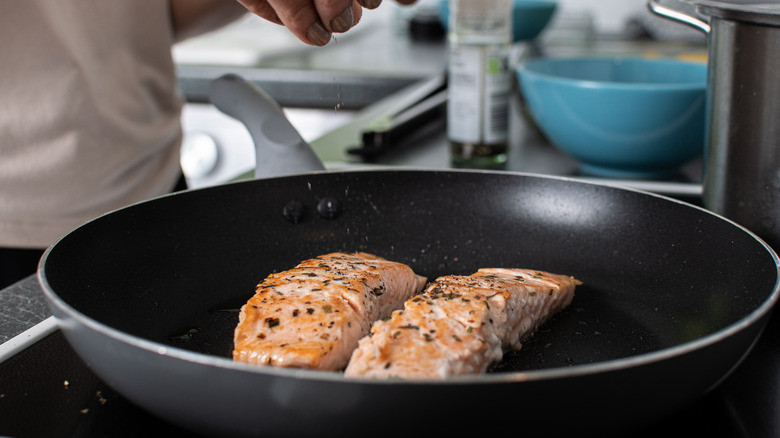The Important Step You Need To Take Before Your Fish Touches The Frying Pan
So, you've scoured the market to select the perfect fresh filet, and asked your local fishmonger to descale your catch to ensure the entire fish is well-cooked. You've planned out a fish feast, so you don't want your dinner flailing. The tiniest adjustments to the seafood preparation process can make or break the whole ordeal.
A nautical meal is basically doomed if you place your fish directly into a cool pan. To serve a successful stovetop smorgasbord, let your frying pan get good and hot. Waiting for the pan to heat with the meat already sitting in a tepid cooking dish will lead to unevenly cooked fish. Crispy, flavorful fish skin is a delicacy, but if the surface of your cookware isn't hot enough, the outside of the fish will cook much faster than the interior, leaving you with a tough, burnt outer layer and an undercooked or even raw inside. Eggs and meat need also a little time before meeting the stovetop, so it's a great rule of thumb to keep in mind when cooking. Additionally, after you've heated the pan, you should also allow your cooking oil to warm up as well before dropping the fish in.
Fish like it hot
Your skillet should already be sizzling, and oil should be shimmering, by the time the fish hits the surface. A hot skillet helps to prevent sticking, and enhances flavor by properly browning crusts. A skillet that has been preheated, will instantly remove any moisturizing from the meat. This way, fats like butter or cooking oil do the work of keeping the skillet slick so your herby lemon butter fish skillet can come out balanced and flavorful. A tepid pan, on the other hand, will pull moisture into it rather than pushing it away, causing your fish to "bond" with the skillet and stick.
Meat sticks to your pan because the proteins in certain foods can start to form chemical bonds with the metal surface. Your fish and frying pan should be acquaintances but not close friends, and proper level of heat helps keep them apart. Otherwise, you'll end up scraping away fish scraps when you clean your beloved non-stick pan. It's also crucial to choose the right pan for cooking fish. Cast irons and stainless steel pans are primed to handle the high temperatures necessary for fantastic fish, and for getting that delicious crispy, browned exterior on your fish. Non-stick pans, on the other hand, can support fragile foods like a flaky fish, but can't always withstand high temperatures.

